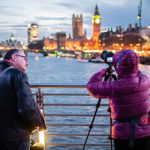It doesn’t happen often, but when it does, it’s amazing and that moment is upon you now. You went out with a couple for a regular run-of-the-mill engagement shoot and, as you sort through images, you realize that one of them is portfolio-worthy and would fare shockingly well in black and white—and perhaps even better with a vintage film grain.
In this short tutorial, Pye explains how to create that timeless vintage effect in Adobe Lightroom 5 with just a few simple steps. He uses lightroom presets to accomplish the deed, but also explains specific image settings and provides additional on-location and workflow advice to consider:
On Location
Scout for great locations.
Don’t just “wing it” during a photo session when choosing locations. Professional photographers always have several perfect locations in mind going into a photoshoot and are prepared to take amazing photos at any of them. The L.A. bridge in the photo used for the tutorial was identified beforehand by Pye as an ideal shooting location because of its amazing “up-ground.”
Compose strategically.
Find those leading lines and eye-catching highlights and find a way to incorporate them into your composition and point to your subjects. In the video, Pye got low to capture the bridge’s up-ground and positioned himself and the couple so that one of the fluorescent lights on the ceiling was right in between the couple. This funnels viewers’ eyes right where the photographer wants them to go and lends the image greater staying power.
“Our eyes go directly to the brighter area of the image. If I can use that highlight and incorporate my subject over it, then our eyes are naturally drawn to that area,” said Pye. “And you’ll notice that I took an angle that allows me to use [the ceiling] lines as leading lines directly to the couple. So, all these lines, they lead to one place, which is love.”
It is also worth mentioning that the photographer observed the rule of thirds by making 2/3 of the image negative space and 1/3 of the image positive space.
Pose them well.
In addition to knowing where to position clients in the frame, it’s equally as important to know how to position them in the frame and with each other. To correctly shoot “up-ground” photos without getting unappealing perspective distortion, ask the couple to lean from the hip towards the camera until they are perpendicular to you.
“It’s going to feel very awkward and uncomfortable for them,” said Pye, “but it’s going to look absolutely great inside your camera, because when you’re shooting perpendicular, you negate that little perspective distortion that you get by shooting bottom up and then you get your background as well, or your up-ground in your shot.”

This photo was the result of expert planning and execution.
Post-Production
Decide whether to use black & white or color.
There are drawbacks to converting a color image to black and white, but those looking to accomplish a timeless, vintage look in a particular image would do well to nix the colors, assuming there are no ultra-modern elements in the image and that the color really isn’t that great to begin with.
Make basic adjustments manually or by using presets.
Using SLR Lounge presets, Pye followed these basic adjustment steps:
- Select “Dark Fade – Filmic B&W” from the BASE – SOFT STYLIZED preset menu.
- Select “Brighten +2.0” from the ADJUST – EXPOSURE preset menu.
- Select “Darken – Medium (-15, -30)” from the ADJUST- SHADOWS BLACKS preset menu.
- Select “Contrast Boost – Heavy” from the ADJUST – CONTRAST preset menu.
- Select “Max Film Grain” from the SFX – FILM & LENS preset menu.
The actual settings controlled by these presets culminate like this:
- Exposure: +2.0
- Contrast: +75
- Highlights: -30
- Shadows: -15
- Whites: -30
- Blacks: -30
- Clarity: -10
- Sharpening: +25
- Sharpening – Radius: +1.5
- Sharpening – Detail: +10
- Sharpening – Masking: +30
- Noise Reduction: 0
- Lens Corrections – Vignetting – Amount: -30
- Lens Corrections – Vignetting – Midpoint: +30
- Grain – Amount: +90
- Grain – Size: +30
- Grain – Roughness: +30
Make local adjustments.
Lightroom is equipped with advanced local adjustment tools, so dodge, burn, clone, add filters, and de-sharpen to your heart’s content. Just remember that it’s often best to take large quantities of local adjustments into Photoshop, since Lightroom tends to lag with local adjustments.
Pye made the following local adjustments to create the final image shown below:
- Graduated Filter: 03 Burn (Darken) -0.5
- Adjustment Brush: 03 Burn (Darken) -0.5
- Adjustment Brush: 43 Heavy Desharpener

The grainy vintage look is also called “filmic.”
Parting Advice
Perform advanced editing very selectively.
Advanced Lightroom editing requires precious time and effort, so decide which images are worth advanced editing and which ones would still greatly benefit from only very minor adjustments. Most of your images will only need basic Lightroom edits, such as color correction and a little sharpening or noise reduction.
“We’re not necessarily spending 5-10 minutes on every single image that we develop. That’s too much time to spend if you have 2,000 images or 1,000 images to be delivering.”
Do your own post production when starting out.
Pye suggests this for two reasons: (1) because you need to develop your own signature post production “style” and (2) because post production will help you to become a better photographer.
“Do every single wedding. Do every single engagement shoot, every single portrait session. Finish all the images yourself until you have that signature style locked in,” said Pye. “If you understand what you can do in post, you’re going to understand how to shoot even better. You’re going to understand the best way to shoot a particular scene based on what you know that you can do inside of Lightroom or inside of Photoshop.”
Only after you have mastered your very own “style” and know how to take great photos should you think about outsourcing your post-processing or hiring in and expanding your business. Then, you’ll be able to devote more time to processing the images that merit advanced editing, doing personal photography projects, connecting with prospective clients, and doing all manner of other activities that will grow your business.
Like This Article?
Don't Miss The Next One!
Join over 100,000 photographers of all experience levels who receive our free photography tips and articles to stay current:






Leave a Reply